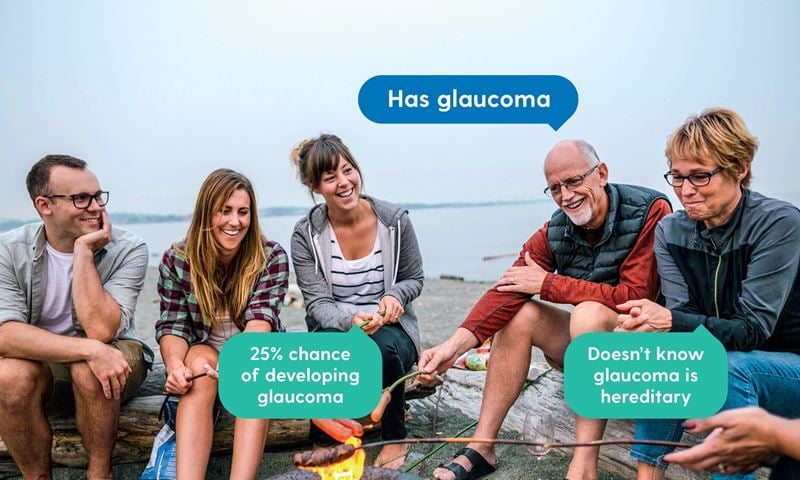Published 01 Feb 2024
Often referred to as ‘the silent thief of sight’, glaucoma is the leading cause of irreversible blindness in Australia and yet many people are unaware that they have it. What is it, who is at risk and what can be done to prevent it?
GMHBA optometrist Alannah Greig answers all your questions about glaucoma.
What is glaucoma?
Glaucoma is one of the most common eye diseases. It occurs when the optic nerve, that sends the visual information from the eye to the brain, is damaged, causing vision loss.
Peripheral (side) vision is typically first to be affected. As glaucoma progresses, a patient progressively loses more side vision until only a ‘tunnel’ of central vision remains. Patients may also become more sensitive to reflective glare, and have difficulty seeing in low light environments.
There are many different types of glaucoma, and some are more common than others. Most patients have Open Angle Glaucoma, which is slow to progress, while the rarer Acute Angle Closure Glaucoma can cause more sudden vision loss. There are many other sub-types of glaucoma.
Am I at risk of developing glaucoma?
The most common way the optic nerve can be damaged is by having high eye pressure (pressure of the clear fluid that fills the eye) and this can be either prolonged or acute (termed ‘angle closure’). However, there are other risk factors which may include:
- having a family history of glaucoma*
- being aged over 50
- being very short- or far-sighted
- having diabetes
- having a history of low or high blood pressure
- frequent migraines
- smoking
- being of African or Asian descent
- having an eye injury or undergoing eye surgery
- prolonged use of steroids
*Those who have a direct relative with glaucoma are 10x more likely and have almost a 1 in 4 chance of developing the condition themselves, so if you have a family history it is important to get checked and let family members know if you have been diagnosed.
How do I know if I have glaucoma?
Glaucoma is largely asymptomatic. That means there are often no symptoms. It is estimated that over 300,000 Australians have glaucoma, but many patients (up to 50%) do not realise they have lost some of their side vision until advanced stages of the disease.
This highlights how important it is to have regular eye tests including an Optical Coherence Tomography (OCT) test.
What is an OCT test?
An OCT scan is a non-invasive scan of the structures at the back of the eye, namely the retina, optic nerves and macula. It is like an ultrasound except that it uses light waves instead of sound waves to generate an image.
An OCT scan helps us to assess the health of the optic nerve. It can indicate early changes, before any side vision is lost and is an excellent diagnostic tool for detecting glaucoma.
Can glaucoma be treated?
Glaucoma cannot be cured but reassuringly, it can be effectively managed by reducing the pressure in the eye(s). This may be managed with eye drops, laser or surgery. While we cannot restore the sight that has been lost, these treatment options have been proven to significantly help slow the deterioration of peripheral vision loss.
I have been asked to do a Visual Field test, what is it and why is it important?
A Visual Field test is a functional measure of your side vision. As this can be lost in glaucoma, it is important to test your side vision regularly to monitor if the disease is progressing. The extent of the loss of side vision also gives your treating specialist an idea about how your glaucoma is impacting your daily activities, like reading, walking and driving, and the extra support that may be available for you.
Will I go blind?
You can go blind from glaucoma if it is left untreated. However, patients who see their optometrist or ophthalmologist for regular eye tests, monitoring for signs of progression, and who follow their treatment plan will have better outcomes and usually retain most of their vision.
Can I still drive if I have glaucoma?
Most glaucoma patients can continue to drive. In advanced stages of the disease, when a certain amount of side vision is lost, a patient may no longer meet the legal driving standards. In this case they may be granted a licence with conditions or lose their licence.
What are the next steps I should take to keep my eyes healthy?
Booking in for regular eye tests is the best way to monitor the health of your eyes and detect glaucoma in its early stages. This becomes increasingly important if you have any of the risk factors, such as if you’re aged over 50 or have a family history of glaucoma. If someone you know may be at risk or is experiencing changes in their vision, encourage them to get their eyes checked as well.
You can book your next appointment online with a GMHBA optometrist and read more about glaucoma at Glaucoma Australia or Vision Australia.



